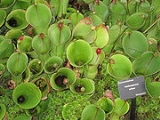
Heliamphora minor
Encyclopedia
Heliamphora minor is a species of Marsh Pitcher Plant
endemic
to the Auyan
and Chimanta group of tepui
s in Venezuela
. As the name suggests, it is the smallest species in the genus
. It is closely related to H. pulchella
.
 Heliamphora minor is one of the more widely available species in the genus for cultivation. Typically, H. minor is grown under strong fluorescent lights in a terrarium, or in a greenhouse with partial sunlight. Like other carnivorous plants, H. minor requires water free from added minerals and chemicals. It can survive a wide range of temperatures, preferably around 70-90°F, however during the night the temperature must drop to around 10 degrees less than the day temperature.
Heliamphora minor is one of the more widely available species in the genus for cultivation. Typically, H. minor is grown under strong fluorescent lights in a terrarium, or in a greenhouse with partial sunlight. Like other carnivorous plants, H. minor requires water free from added minerals and chemicals. It can survive a wide range of temperatures, preferably around 70-90°F, however during the night the temperature must drop to around 10 degrees less than the day temperature.
Although it is carnivorous, H. minor does not need to be fed to live or thrive.
Soil for H. minor must be low in nutrients. Combinations of washed sand, orchid bark, long fibered sphagnum moss (dried or living), peat moss, and perlite may be used.
Heliamphora plants also require a high humidity level, which can be achieved in a greenhouse or terrarium.
H. minor var. minor and H. minor var. pilosa, which is characterised by conspicuous hairs on the pitcher exterior.
Heliamphora
The genus Heliamphora contains 23 species of pitcher plants endemic to South America. The species are collectively known as sun pitchers, based on the mistaken notion that the heli of Heliamphora is from the Greek helios, meaning "sun"...
endemic
Endemic (ecology)
Endemism is the ecological state of being unique to a defined geographic location, such as an island, nation or other defined zone, or habitat type; organisms that are indigenous to a place are not endemic to it if they are also found elsewhere. For example, all species of lemur are endemic to the...
to the Auyan
Auyantepui
Auyantepui, also Auyantepuy, Auyan-Tepui, or Aiyan-Tepui, is a tepui plateau in the Gran Sabana region of the Bolivar State in Venezuela. It is one of the largest tepuis in the Guiana Highlands, with an area of .Angel Falls, the tallest waterfall in the world, drops from a cleft near the summit...
and Chimanta group of tepui
Tepui
A tepui , or tepuy, is a table-top mountain or mesa found in the Guiana Highlands of South America, especially in Venezuela. The word tepui means "house of the gods" in the native tongue of the Pemon, the indigenous people who inhabit the Gran Sabana....
s in Venezuela
Venezuela
Venezuela , officially called the Bolivarian Republic of Venezuela , is a tropical country on the northern coast of South America. It borders Colombia to the west, Guyana to the east, and Brazil to the south...
. As the name suggests, it is the smallest species in the genus
Genus
In biology, a genus is a low-level taxonomic rank used in the biological classification of living and fossil organisms, which is an example of definition by genus and differentia...
. It is closely related to H. pulchella
Heliamphora pulchella
Heliamphora pulchella is a species of Marsh Pitcher Plant endemic to the Chimanta group of tepuis in Venezuela. It is one of the smallest species and closely related to H...
.
Cultivation

Although it is carnivorous, H. minor does not need to be fed to live or thrive.
Soil for H. minor must be low in nutrients. Combinations of washed sand, orchid bark, long fibered sphagnum moss (dried or living), peat moss, and perlite may be used.
Heliamphora plants also require a high humidity level, which can be achieved in a greenhouse or terrarium.
Infraspecific taxa
Two major variants of H. minor are known: the autonymAutonym (botany)
In botanical nomenclature, autonyms are automatically created names, as regulated by the International Code of Botanical Nomenclature . Autonyms are cited without an author. Relevant provisions are in articles 6.8, 22.1-3 and 26.1-3....
H. minor var. minor and H. minor var. pilosa, which is characterised by conspicuous hairs on the pitcher exterior.

